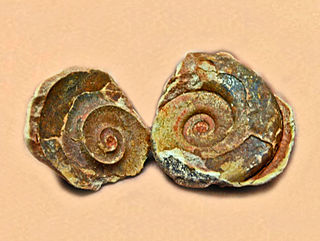
Ammonitida is an order of more highly evolved ammonoid cephalopods that lived from the Jurassic through Cretaceous time periods, commonly with intricate ammonitic sutures.
Albanites is a genus of extinct cephalopods belonging to the ammonoid order Ceratitida that lived during the Early Triassic.
Algerites is middle Cretaceous (Cenomanian) anisoceratid ammonoid with a close-coiled adult shell in which the whorls at that stage are in close contact, after starting off with openly coiled whorls, and in which every rib has a pair of sharp ventral tubercles.

Audaxlytoceras is an extinct genus of lytoceratid ammonites.

Ceratitida is an order that contains almost all ammonoid cephalopod genera from the Triassic as well as ancestral forms from the Upper Permian, the exception being the phylloceratids which gave rise to the great diversity of post Triassic ammonites.

Parahoplitidae is an extinct family of Cretaceous ammonites with stoutly ribbed, compressed, generally involute shells lacking or with only minor tubercles included in the Deshayestoidea, a superfamily now separated from the Hoplitacaceae.

The Xenodiscaceae is a superfamily within the ammonoid order Ceratitida. The Xenodiscaceae, named by Frech in 1902, presently contains ten families, only one of which was included in the original Otocerataceae of Hyatt, 1900, the remaining having been added.

The Xenodiscidae are the earliest of the Ceratitida and comprise Middle and Upper Permian genera characterized by compressed, discoidal, evolute shells with rounded to acute venters and commonly with lateral ribs. Sutures are goniatitic to weakly ceratitic.
Ancyloceratoidea, formerly Ancylocerataceae, is a superfamily of typically uncoiled and loosely coiled heteromorph ammonoids established by Alpheus Hyatt in 1900, that may contain as many as 11 families, depending on the classification accepted.

Amaltheidae is a family of eoderoceratoidean ammonitids from the Lower Jurassic consisting of genera characterised by stigated discoidal oxycones—narrow involute shells with narrowly rounded to angular venters that bear a series of grooves, or ridges, along broad flanks, which according to the Treatise L, 1957, evolved into strongly ribbed planulates with quadrate whorls, typically with crenulated keels; involving all together four genera.

Liparoceratidae is a family of eoderoceratoidean ammonites from the Lower Jurassic that combines genera with a variety of forms including dimorphs that change from one form to another during ontogeny.

Turrilites is a genus of helically coiled ammonoid cephalopods from the lower part of the Upper Cretaceous ; generally included in the Ancyloceratina. Previously it was included in the ammonoid suborder, Lytoceratina.
The Haploceratidae is the type family of the Haploceratoidea, a superfamily in the ammonitina; which according to Donovan et al. (1981) can be derived from the Taramelliceratinae, a subfamily of the Oppeliidae.
Aplococeratidae is a family of ceratitids from the Middle Triassic with very simplified sutures and a tendency to lose their ornamentation. Shells are generally evolute, more or less compressed, with rounded venters. Ornamentation if present consists of umbilical ribs that disappear outwardly, toward the venter. The suture is ceratitic or goniatitic.
Turrilitina is a proposed suborder of Cretaceous heteromorph ammonoid cephalopods derived from the Lytoceratidae in the Hauterivian stage of the Lower Cretaceous that would include the superfamilies Turrilitoidea, Ptychoceratoidea, and Scaphatoidea.
The Hungaritidae comprises a family of ceratitid ammonites described in the Treatise,(Arkell et al. 1957), as involute compressed, discoidal, with keeled or sharpened venter, smooth to weakly costate. Sutures ceratitid, usually with numerous elements.
Meekoceras is a genus of ceratitid ammonites with a discoidal shell that lived during the Early Triassic Epoch.
Euomphaloceratinae is a subfamily of Upper Cretaceous ammonites included in the Acanthoceratidae, characterized by generally evolute shells with quadrate whorl sections that are strongly ribbed. Sutures are ammonitic, but not overly complex.
Euomphaloceras is an early Upper Cretaceous ammonite genus,, included in the Acanthoceratinae until established as the type genus for the Euomphaloceratinae by Cooper, 1978.

Halorites is an extinct genus of Triassic ammonoids belonging to the family Haloritidae.








